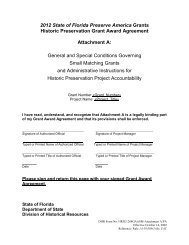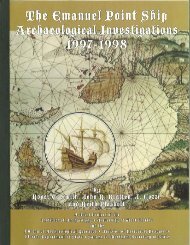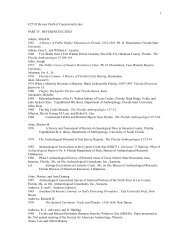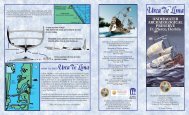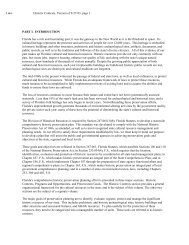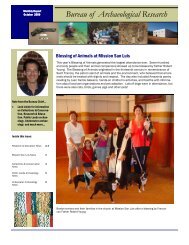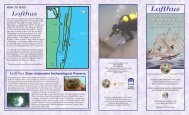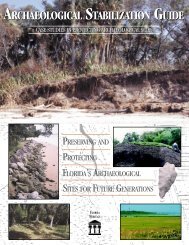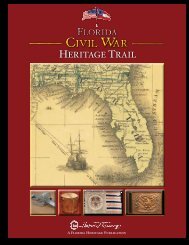Conservation Easements: Protecting Archaeological Sites and ...
Conservation Easements: Protecting Archaeological Sites and ...
Conservation Easements: Protecting Archaeological Sites and ...
You also want an ePaper? Increase the reach of your titles
YUMPU automatically turns print PDFs into web optimized ePapers that Google loves.
<strong>Conservation</strong> <strong>Easements</strong>:<strong>Protecting</strong> <strong>Archaeological</strong> <strong>Sites</strong> <strong>and</strong>Historic Buildings on Private L<strong>and</strong>sBureau of <strong>Archaeological</strong> ResearchDivision of Historical Resources<strong>Conservation</strong> <strong>Easements</strong>: <strong>Protecting</strong> <strong>Archaeological</strong> <strong>Sites</strong> <strong>and</strong> Historic Buildings on Private L<strong>and</strong>s 1
2<strong>Conservation</strong> <strong>Easements</strong>: <strong>Protecting</strong> <strong>Archaeological</strong> <strong>Sites</strong> <strong>and</strong> Historic Buildings on Private L<strong>and</strong>s
IntroductionFlorida is home to a rich variety of historical <strong>and</strong> cultural resources. Theyinclude 12,000 year old Native American sites, the remains of earlyEuropean settlements, <strong>and</strong> more recently, Mediterranean Revival homes <strong>and</strong>Art Deco buildings. While many significant historic structures <strong>and</strong>archaeological sites are in public ownership, private l<strong>and</strong>holders ownsignificantly more, <strong>and</strong> thus, are able to preserve these tangible remains ofFlorida’s past for the future. If you own an historic building or anarchaeological site, you can play an active role in its preservation by placinga conservation easement on your property. A conservation easement offersproperty owners flexibility in l<strong>and</strong> management while at the same timeprotecting some of Florida’s history. Additionally, it can afford propertyowners tax benefits.Conlin Isl<strong>and</strong> conservation easement,located in Lake Iamonia nearTallahassee, FL, includes the protectionof cultural resources. State of Floridaarchaeologists found this artifact atConlin Isl<strong>and</strong> during an archaeologicalsurvey conducted in partnership withRed Hills <strong>Conservation</strong> Program of TallTimbers Research Station. The artifact isa pinched-rim sherd of Lake Jackson Plainstyle, placing it in the Ft. Walton Period,ca. 1250-1450 AD. Norwood Plain <strong>and</strong>Deptford Plain sherds, along with lithicartifacts recovered suggest that ConlinIsl<strong>and</strong> may have been inhabited as early as 2500 years ago. Often surveys areconducted on conservation easements to determine what resources exist onthe property <strong>and</strong> where they are located. The Conlin Isl<strong>and</strong> <strong>Conservation</strong>Easement map (next page) shows the location of archaeologically sensitiveareas found during the archaeological survey of the isl<strong>and</strong>. Each propertybeing placed under conservation easement is assessed based on the needs ofthe owner. Sometimes extensive surveys will be conducted, <strong>and</strong>, other times,just a walk around the property is all that is required.<strong>Conservation</strong> <strong>Easements</strong>: <strong>Protecting</strong> <strong>Archaeological</strong> <strong>Sites</strong> <strong>and</strong> Historic Buildings on Private L<strong>and</strong>s 3
What is a conservation easement?<strong>Conservation</strong> easements may apply to a variety of resources. Broadlyapplied, a conservation easement is a legal agreement a property ownermakes with a nonprofit or government organization to protect cultural <strong>and</strong>natural resources on his property. A property owner holds a certain numberof rights, such as the right to subdivide his l<strong>and</strong>, restrict its access, orconstruct a building on it. By agreeing to place property under a conservationeasement, the property owner, or “grantor,” agrees to donate, lease, or sellsome or all of these rights to a nonprofit organization. This organization4<strong>Conservation</strong> <strong>Easements</strong>: <strong>Protecting</strong> <strong>Archaeological</strong> <strong>Sites</strong> <strong>and</strong> Historic Buildings on Private L<strong>and</strong>s
ecomes the easement holder or “grantee,” who is responsible for monitoringthe property for activities that would be contrary to the conditions of theeasement. Depending on the resources they protect, conservation easementsare known by several different names. For example, an agricultural easementwould protect a family farm. Types of conservation easements commonlyused to protect historic buildings <strong>and</strong> archaeological sites are the primaryfocus of this pamphlet <strong>and</strong> include historic preservation easements <strong>and</strong> openspace or scenic easements.Why place a conservation easementon your property?<strong>Conservation</strong> easements are uniquely tailored to meet the needs of theindividual property owner. They allow property owners to protect specificresources on their property while retaining ownership. An owner can choosewhich portions of the property he wishes to protect <strong>and</strong> which to excludefrom protective covenants of the easement. He may also wish to allowlimited public access, such as historic house tours or recreational activities,like hunting <strong>and</strong> fishing, provided they do not endanger the protected area ofthe property. Such limitations would be included in the terms of theeasement.Creating historic preservation easements <strong>and</strong> open space <strong>and</strong> sceniceasements on your property may ensure the preservation of historicalresources as a legacy for future generations. Furthermore, they have thepotential, through public access, to provide a community with manyeducational benefits. Economic benefits to conservation easements also exist.Tax incentives may include reduction in property, estate, <strong>and</strong> federalincome taxes.<strong>Conservation</strong> <strong>Easements</strong>: <strong>Protecting</strong> <strong>Archaeological</strong> <strong>Sites</strong> <strong>and</strong> Historic Buildings on Private L<strong>and</strong>s 5
What types of conservation easements protecthistorical <strong>and</strong> cultural resources <strong>and</strong> how arethey used?Historic preservation easements <strong>and</strong> open space or scenic easements aregenerally used to protect historic structures <strong>and</strong> archaeological sites.Historic Preservation <strong>Easements</strong>Historic preservation easements may protect both historic structures <strong>and</strong>archaeological sites. There are two categories of historic preservationeasements.1. Exterior or Façade <strong>Easements</strong>This type of easement protects the outside appearance of a building.Usually it restricts alterations or additions to a structure that mayharm its integrity <strong>and</strong> historic character.The Matheson House, in Gainesville, FL, is held under an exterior or facade easement bythe Florida Trust for Historic Preservation.Typically, the lot <strong>and</strong> air rights (development rights for construction ofadditional stories to a building) are covered by this easement. For example,an owner would agree not to add stories or additions to his property, if thealterations would change the appearance of the building <strong>and</strong> compromise itsarchitectural style <strong>and</strong> historic quality.6<strong>Conservation</strong> <strong>Easements</strong>: <strong>Protecting</strong> <strong>Archaeological</strong> <strong>Sites</strong> <strong>and</strong> Historic Buildings on Private L<strong>and</strong>s
What are the tax incentives for conveyingan easement?Three types of tax benefits are available to owners who wish to place theirproperty under a protective easement. These are:1. Property taxesPlacing a property under an easement lowers the property’s fair market valuebecause it restricts the use of the l<strong>and</strong>. This can result in a reduction ofproperty taxes. State <strong>and</strong> local law as well as individual tax assessmentdetermine the amount of this reduction. Florida law requires propertyappraisers to recognize the reduced market value of a property undereasement. (See Sections 193.501 <strong>and</strong> 193.503, Florida Statutes).2. Estate taxes<strong>Conservation</strong> easements allow families to permanently protect their l<strong>and</strong>without giving up ownership. Children who have inherited l<strong>and</strong> from theirfamilies often cannot afford the estate taxes <strong>and</strong> are forced to sell it. Byplacing an easement on family l<strong>and</strong> that restricts its future development, theproperty’s overall value is reduced, which results in lower taxes.3. Federal income taxesA property owner who donates a conservation easement may be eligible for afederal income tax deduction if the property under easement meets specificcriteria. According to the IRS code, to be eligible for a federal income taxdeduction, the easement must be donated in perpetuity to a qualifiedorganization such as an historical society or a l<strong>and</strong> trust, <strong>and</strong> for conservationpurposes only. The IRS code allows tax deductions for donation ofconservation easements in five resource categories:1. public recreation <strong>and</strong>/or education2. significant natural resource3. scenic enjoyment4. pursuant to local government policy5. historic preservationTwo types of cultural resources qualify for historic preservation income taxdeductions. These are a “historically important l<strong>and</strong> area” <strong>and</strong> a “certifiedhistoric structure.” To be considered “historically important,” properties must<strong>Conservation</strong> <strong>Easements</strong>: <strong>Protecting</strong> <strong>Archaeological</strong> <strong>Sites</strong> <strong>and</strong> Historic Buildings on Private L<strong>and</strong>s 9
meet National Register criteria or be associated with a National Registerlisted property. This can include a battlefield, a st<strong>and</strong>ing structure or anarchaeological site. A certified historic structure is one placed on theNational Register of Historic Places or listed as a contributing element to aNational Register district as certified by the Secretary of the Interior.In order to receive an income tax deduction using the historic preservationresource category, the property must also be accessible to the public.Accessibility to the public can be as simple as maintaining visibility from theright of way of a property, or in the case of an interior easement, opening thebuilding up for tours.In some cases, archaeological sites fall under “scenic enjoyment” because ofthe broad definition the IRS code applies to this resource category. The IRScode, also through broad application, allows archaeological sites to becategorized pursuant to the local government policy. The federal governmentrecognizes local governmental efforts to conserve open spaces, as long aslocal government, at any level, clearly delineates the types of open spaces itwants to protect.Florida has established laws pertaining to conservation easements. Section704.06, Florida Statutes, defines a conservation easement as “a right orinterest in real property which is appropriate to retaining l<strong>and</strong> or water areaspredominantly in their natural, scenic, open, agricultural, or woodedcondition; retaining such areas as suitable habitat for fish, plants, or wildlife;retaining the structural integrity or physical appearance of sites or propertiesof historical, architectural, archaeological, or cultural significance; ormaintaining existing l<strong>and</strong> uses.” The law also stipulates that conservationeasements:• are perpetual, undivided interests in the property.• are held by governmental agencies or bodies or by non-profitorganizations.• will always be part of the deed <strong>and</strong> be binding for all future owners.• can be enforced either through an injunction or proceeding.• may provide for a third-party right of enforcement(such as a site steward).10<strong>Conservation</strong> <strong>Easements</strong>: <strong>Protecting</strong> <strong>Archaeological</strong> <strong>Sites</strong> <strong>and</strong> Historic Buildings on Private L<strong>and</strong>s
• can be affected by actions taken by the owner of the property, theholder of the easement, the person of group designated as havingthe third-party right of enforcement, or person authorized byanother law.How can donating an easement reduce aproperty owner’s income tax?The value of an easement donation determines the federal income taxdeduction. The value of the easement donation is the calculated differencebetween the property’s fair market value without easement restrictions <strong>and</strong> itsfair market value with easement restrictions. According to the IRS code, anyowner who makes a charitable donation of property is eligible to deduct up to30 percent of his adjusted gross income each year, for a total of 6 years, oruntil the full amount of the donation has been deducted.Example:* Appraised fair market value of the property without easement: $600,000* Appraised fair market value of the property with easement: $500,000* Amount of easement donation: $100,000* The property owner is entitled to a charitable deduction of $100,000* Annual adjusted gross income: $50,000.00 x 30% = $15,000.00* The owner can deduct annually $15,000.00 until $100,000 has beenreached, or until 6 years elapses, for a total of $90,000Property owners may be eligible for other tax savings <strong>and</strong> should contact atax lawyer for further information <strong>and</strong> advice. It is also important toremember that to be eligible to receive federal income tax benefits using thehistoric preservation resource category, archaeological sites <strong>and</strong> historicstructures must be eligible for or listed on the National Register of HistoricPlaces. Contact the Division of Historical Resources for information on theNational Register program.<strong>Conservation</strong> <strong>Easements</strong>: <strong>Protecting</strong> <strong>Archaeological</strong> <strong>Sites</strong> <strong>and</strong> Historic Buildings on Private L<strong>and</strong>s 11
Where to go from here?Contact an attorneyIf you are interested in having an easement placed on your l<strong>and</strong> you shouldconsult with an attorney. An attorney can advise you of your easementoptions, your rights <strong>and</strong> responsibilities, <strong>and</strong> how to make appropriatedecisions regarding the ownership <strong>and</strong> value of your property.Contact Division of Historical ResourcesArchaeologists <strong>and</strong> historic preservationists located at the state office canprovide you with professional assistance <strong>and</strong> information on identifying,documenting, <strong>and</strong> evaluating the significance of an historic building orarchaeological site that is located on your property. They can also assist youin determining the National Register status of your site <strong>and</strong> how to bestmanage <strong>and</strong> protect it.Florida Division of Historical ResourcesR. A. Gray Building500 South Bronough StreetTallahassee, FL 32399-0250(850) 245-6300www.flheritage.comContact a l<strong>and</strong>-trust organizationL<strong>and</strong>trusts are private, nonprofit conservation organizations that can help youcreate a conservation easement that meets your needs. They can also directyou to historic preservation organizations, attorneys, <strong>and</strong> accountants. Thefollowing l<strong>and</strong>-trust organizations hold conservation easements to protecthistoric <strong>and</strong> archaeological resources within the state of Florida:Florida L<strong>and</strong> Trust Network1129 Alam<strong>and</strong>a LaneStuart, Florida 34996(772) 219-345712<strong>Conservation</strong> <strong>Easements</strong>: <strong>Protecting</strong> <strong>Archaeological</strong> <strong>Sites</strong> <strong>and</strong> Historic Buildings on Private L<strong>and</strong>s
Florida Trust for Historic PreservationP.O. Box 11206Tallahassee, FL 32303(850) 224-8159www.floridatrust.org/index.cfmRed Hills <strong>Conservation</strong> ProgramTall Timbers Research StationRoute 1, Box 678Tallahassee, FL 32312(850) 893-4153www.talltimbers.orgAlso, contact your local municipal or county government to inquire ifthey hold conservation easements to protect archaeological sites.The Red Hills <strong>Conservation</strong> Program protects the Bannerman house, near Tallahassee, Florida underan exterior or facade easement.<strong>Conservation</strong> <strong>Easements</strong>: <strong>Protecting</strong> <strong>Archaeological</strong> <strong>Sites</strong> <strong>and</strong> Historic Buildings on Private L<strong>and</strong>s 13
Related Internet <strong>Sites</strong>Florida Division of Historical Resources: http://www.flheritage.comL<strong>and</strong> Trust Alliance: http://www.lta.orgTrust for Public L<strong>and</strong>: http://www.tpl.orgTechnical Preservation Services for Historic Buildings, NPS:http://www2.cr.nps.gov/tps/tax/easement.htmNational Trust for Historic Preservation: http://www.nationaltrust.orgFlorida State Statutes: http://www.flsenate.gov/statutes/Further readingBarrett, Thomas S. <strong>and</strong> Stefan Nagel1996 Model <strong>Conservation</strong> Easement <strong>and</strong> Historic Preservation Easement, 1996. L<strong>and</strong>Trust Alliance, Washington, D.C.Diehl, Janet <strong>and</strong> Thomas S. Barrett1988 The <strong>Conservation</strong> Easement H<strong>and</strong>book: Managing L<strong>and</strong> <strong>Conservation</strong> <strong>and</strong>Historic Preservation Easement Programs. L<strong>and</strong> Trust Exchange <strong>and</strong> Trust forPublic L<strong>and</strong>, Alex<strong>and</strong>ria, VA.Henry, Susan1993 <strong>Protecting</strong> <strong>Archaeological</strong> <strong>Sites</strong> on Private L<strong>and</strong>s. U.S. Department of the Interior,Washington D.C.Hutchinson, Robert <strong>and</strong> Nina L Mattei1991 L<strong>and</strong> Preservation for Floridians. The Florida L<strong>and</strong> Trust Association,Gainesville, FL.L<strong>and</strong> Trust Alliance1996 <strong>Conservation</strong> Options: A L<strong>and</strong>owner’s Guide. Washington D.C.L<strong>and</strong> TrustAlliance & National Trust for Historic Preservation1990 Appraising <strong>Easements</strong>: Guidelines for the Valuation of Historic Preservation <strong>and</strong>L<strong>and</strong> <strong>Conservation</strong> <strong>Easements</strong>. L<strong>and</strong> Trust Alliance, Washington, D.C.Lind, Brenda1991 The <strong>Conservation</strong> Stewardship Guide: Designing, Monitoring, <strong>and</strong> Enforcing<strong>Easements</strong>. L<strong>and</strong> Trust Alliance <strong>and</strong> Trust for New Hampshire L<strong>and</strong>s,Washington, D.C.14<strong>Conservation</strong> <strong>Easements</strong>: <strong>Protecting</strong> <strong>Archaeological</strong> <strong>Sites</strong> <strong>and</strong> Historic Buildings on Private L<strong>and</strong>s
Small, Stephen J.1992 Preserving Family L<strong>and</strong>s: A L<strong>and</strong>owner’s Introduction to Tax Issues <strong>and</strong> OtherConsiderations. L<strong>and</strong>owner Planning Center, Boston, MA.U.S. Department of the Interior1997 Historic Preservation <strong>Easements</strong>: A Historic Preservation Tool with Federal TaxBenefits. National Park Service, Washington, D.C.<strong>Archaeological</strong> remains of Verdura, a plantation home in Leon County, Florida. A few classicallystyled pillars are still st<strong>and</strong>ing. (Photography courtesy of Florida Memory Project: FloridaPhotographic Collection.)<strong>Conservation</strong> <strong>Easements</strong>: <strong>Protecting</strong> <strong>Archaeological</strong> <strong>Sites</strong> <strong>and</strong> Historic Buildings on Private L<strong>and</strong>s 15
For more information on protecting culturalresources in Florida, like Site Stewardship, SiteWatch, public access to sites, <strong>and</strong> generalinformation about site conservation, visit oour website at www.flheritage.com/protection or contactthe Florida Bureau of <strong>Archaeological</strong> Research viaemail at sitewatch@mail.dos.state.fl.us or by phoneat (850) 487-2299.Lakeside Inn, located in Mt. Dora, Florida, is one ofseveral historic structures the Florida Trust for HistoricPreservation holds under easement.Cover photo: Foshalee Plantation <strong>Conservation</strong> EasementCopyright 2000 by the Florida Department of State, Tallahassee, FloridaJeb BushGovernor of FloridaGlenda E. HoodSecretary of StateFLORIDA DEPARTMENT OF STATEDivision of Historical ResourcesBureau of <strong>Archaeological</strong> Research500 South Bronough Street • Tallahassee, Florida 32399-0250FLORIDAHERITAGEA publication funded by the Florida Department of Community Affairs, Florida Coastal ManagementProgram, National Oceanic <strong>and</strong> Atmospheric Administration Award No. NA97OZ0158. The viewsexpressed herein are those of the author(s) <strong>and</strong> do not necessarily reflect the views of the State ofFlorida, NOAA or any of its subagencies.16<strong>Conservation</strong> <strong>Easements</strong>: <strong>Protecting</strong> <strong>Archaeological</strong> <strong>Sites</strong> <strong>and</strong> Historic Buildings on Private L<strong>and</strong>s



